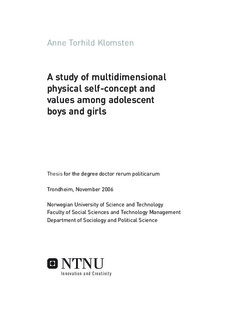| dc.description.abstract | Gender seems to play a decisive role in adolescent’s physical self-concept and values. Boys for example score higher than girls on physical self-concept, and they also place more importance on doing well in sports compared to girls. In the present dissertation the focus has been on gender differences in adolescent’s physical self-concept and values.
Self-concept research has more recently suggested that physical self-concept is multidimensional, and one measure that has been developed to measure multidimensional physical self-concept is The Physical Self-Description Questionnaire (PSDQ). This measure consists of nine specific domains as well as global physical and global self-esteem. Few physical self-concept instruments have been translated into Norwegian, and certainly not recently. In the present dissertation, one aim (Study I) therefore was to translate the Australian PSDQ into Norwegian and to test this measure in a Norwegian population. The factor structure was satisfying and indicates that the Norwegian version of the PSDQ is a useful instrument for measuring multidimensional physical self-concept in a Norwegian sample. Furthermore, the PSDQ also seem to be a valuable research tool among children as young as 10 and 11 years of age, especially when a five-point respond scale is used.
A second aim (Study II) was to explore whether gender differences in multidimensional physical self-concept could be found, and if differences were found, did they run along gender-stereotypical lines. Not surprisingly, boys scored higher than girls in strength, sports competence, physical activity, and endurance. However, girls did not score higher than boys on flexibility that is gender stereotyped as a typical feminine feature. Boys were also significantly more positive than girls when describing their global self-esteem, global physical, body fat, coordination and health.
These differences in physical self-concept are not necessarily based on biology, but may just as well be a result of general gender stereotypical attitudes, and therefore the third aim (Study III) of the present dissertation was to investigate whether gender differences emerged regarding to what boys and girls emphasized concerning physical attributes; Appearance (-strength, -slender, -good looking face, -good looking body) as well as Strength, Endurance, Sports Competence, Flexibility, Masculinity and Femininity. The results showed that boys rated appearance strength, sports competence, endurance and strength as significantly more important to them compared to girls, whereas girls rated appearance good looking face and appearance slender significantly more important to them than did boys. Boys and girls also differed in sport involvement. Whereas more boys participated in sports traditionally characterized as masculine, more girls participated in typically feminine sports.
Neither gender differentiated beliefs, nor self-conceptions develop in a vacuum, and ample evidence documents that significant others may contribute to the shaping of these beliefs and self-perceptions over time. Parents do for example treat boys and girls differently when it comes to physical activity and sport, and such attitudes could very well influence how adolescent boys and girls come to rate the importance of different characteristics. The fourth aim (Study IV) in this thesis was therefore to investigate whether boys and girls differed in which physical features they perceived as important to their significant others. The results revealed gender differences in how boys and girls perceived significant others’ values. The major differences between boys and girls were evident on the strength and appearance strength dimensions. Furthermore the results demonstrated a gender variation in the relation between adolescents own perceptions of different physical features and significant others perception of the same physical qualities (as perceived by adolescents).
In conclusion, the present dissertation has demonstrated that what we think of as conventional stereotypes do exist in adolescent boys’ and girls’ perceptions today. This dissertation suggests that the kind of physical features boys and girls come to rate as important is influenced by social expectations and role models. These expectations may further influence their physical self-concept and manifest in their participation and involvement in differing sport activities. These findings highlight that a more conscious view of gender is required in school and sport settings. | nb_NO |
